Welcome to the world of efficient file ownership management with the powerful capability of chown recursive. Whether you're navigating the Linux ecosystem, orchestrating tasks with Ansible, diving into Python development, managing Docker containers, or even fine-tuning permissions on your Mac system, understanding and harnessing the prowess of linux chown recursiveis essential.
Imagine a scenario where you need to swiftly and comprehensively adjust ownership permissions across directories and files. This is precisely where the magic of chown recursive comes into play. With a single command, you can seamlessly cascade ownership changes throughout a folder hierarchy, ensuring that every file and subdirectory reflects the desired ownership settings.
In the Linux realm, the command ansible chown recursive is your go-to tool for managing ownership at scale. Whether you're administering a server, configuring user environments, or securing sensitive data, the ability to recursively modify ownership ensures efficiency and precision.
In the realm of infrastructure automation, tools like Ansible leverage chown recursive to streamline configuration management. With a few lines of code, you can automate the process of setting ownership across multiple servers or virtual machines, saving time and reducing the risk of human error.
When developing in Python, chown recursive empowers you to manage file ownership programmatically. By integrating this functionality into your scripts, you can automate routine tasks and maintain consistency across your project directories.
Within Docker environments, the docker copy chown recursive command facilitates the seamless transfer of files while preserving ownership settings. Whether you're building containerized applications or managing data volumes, chown recursive folder ensures that ownership remains intact throughout the deployment process.
For Mac users, the chown use recursive mac command provides a straightforward solution for adjusting ownership permissions. Whether you're a developer, designer, or power user, chown recursive directory offers a versatile approach to managing file ownership within the macOS ecosystem.
In situations where chown recursive not working may arise, troubleshooting and understanding the underlying mechanisms can be crucial. By exploring potential issues such as permissions conflicts or syntax errors, you can effectively resolve any obstacles to seamless ownership management.
Furthermore, chown recursively to current user, and chown recursive mac simplifies the process of transferring ownership to the user executing the command, streamlining administrative tasks and enhancing security protocols.
Whether you're dealing with a single directory or an entire file system, chown recursive all files and folders, and chown recursive hidden files ensures that ownership changes are applied comprehensively, sparing you the need for manual intervention and enabling efficient system administration.
In essence, python chown recursi, and linux chown recursive current directory is not just a command—it's a versatile tool that empowers users across diverse environments to manage file ownership with ease and precision. So, dive in, explore its capabilities, and elevate your file management workflows to new heights.
Enhance your server management skills and get the best performance with our Linux VPS solutions 🚀. Explore now!
What is chown?
Imagine you're the conductor of a grand symphony, orchestrating permissions and ownership across your digital landscape. In this symphony, chown stands as your baton, allowing you to direct who holds the rights to which files and directories within your Linux or Unix-based operating system.
Chown, short for "change owner," is a command-line utility that grants users the power to modify the ownership of files and directories. It's your ticket to controlling who can access and manipulate the treasures within your system's depths.
Now, let's dive into the harmonious capabilities of chown recursive. Just as a maestro molds the sound of an entire orchestra, chown recursive extends its influence beyond individual files, permeating through entire directory structures. Need to transfer ownership across a plethora of folders? Simply wield the chown recursive command like a magic wand, and watch as permissions cascade effortlessly, ensuring consistency and efficiency throughout.
Picture this scenario: You're managing a sprawling infrastructure using Ansible, the beloved automation tool. With chown recursive Ansible commands at your fingertips, you can automate ownership changes across countless servers, seamlessly syncing permissions and freeing up valuable time for more creative endeavors.
But what if you need to relinquish ownership to all users within a system? Fear not, for chown recursive all users, and chown recursive all folders provides the solution. With a single command, you can democratize access, allowing everyone to partake in the digital bounty.
Sometimes, however, it's not just about who holds the keys, but what they can do with them. Enter chmod recursive all files and folders. With this command, you're not just handing over ownership, you're fine-tuning permissions, granting or restricting the ability to read, write, and execute across entire directory trees.
Perhaps you find yourself needing to elevate permissions for a select group of users. With chmod recursive add write and chmod recursive add read, you can bestow specific privileges with surgical precision, ensuring that only those entrusted with the power can wield it.
But what about when you need to grant carte blanche—chmod recursive all permissions delivers just that. With a single stroke, you can open the floodgates, allowing users to exercise their rights across the board.
To illustrate, let's consider a practical chown recursive example: You've inherited a directory structure rife with ownership discrepancies. Armed with the knowledge of how to chown recursively, you embark on a quest to restore order. With a deft application of the chown recursive command and a judicious eye, you harmonize permissions, transforming chaos into coherence.
And what about navigating within the confines of your current directory? Fear not, for chown recursive current directory ensures that your commands remain focused and targeted, sparing neighboring structures from unintended alterations.
In essence, chown recursive is more than just a tool—it's your baton in the symphony of ownership, conducting harmony amidst the cacophony of permissions. So, wield it wisely, and let your system sing with the sweet melody of controlled access.
Recursive Chown vs Standard Chown
When it comes to managing file ownership in the intricate ecosystem of Unix-like operating systems, two methodologies stand out: Recursive Chown and Standard Chown. Both wield power over ownership settings, yet each operates within a distinct realm of efficiency and scope.
First, let's unravel the tapestry of Standard Chown command. This venerable command allows users to modify the ownership of individual files or directories with surgical precision. Need to transfer ownership of a single file? Standard Chown steps in with elegance and simplicity, offering a straightforward solution to a singular problem.
Now, contrast this with the expansive capabilities of Recursive Chown. Like a master key that unlocks entire corridors, Recursive Chown transcends the boundaries of individual entities, permeating through entire directory structures with seamless efficiency. Imagine a scenario where you need to transfer ownership across a labyrinth of folders and files. Recursive Chown emerges as your stalwart companion, effortlessly cascading permissions throughout the hierarchy, ensuring consistency and coherence with every stroke.
Consider, for instance, a scenario where you've inherited a sprawling project directory with nested subdirectories and countless files. With Recursive Chown at your disposal, the task of standardizing ownership becomes a breeze. With a single command, you can traverse through the entire directory tree, effortlessly transferring ownership and restoring order amidst the chaos.
But the true magic of Recursive Chown shines brightest in scenarios where time is of the essence and precision is paramount. Let's say you're administering a server environment, tasked with synchronizing ownership settings across multiple users and directories. With Recursive Chown, you can automate this process with finesse, streamlining administrative tasks and reducing the risk of human error.
Furthermore, Recursive Chown isn't just confined to local file systems. In the realm of networked environments and distributed systems, it serves as a versatile tool for orchestrating ownership changes across interconnected nodes and servers, ensuring uniformity and consistency across the digital landscape.
In essence, Recursive Chown and Standard Chown represent two sides of the same coin—each valuable in its own right, yet tailored to suit distinct needs and scenarios. Whether you're navigating the intricate pathways of a local directory structure or orchestrating ownership changes across a sprawling networked environment, Recursive Chown stands as a stalwart ally, offering efficiency, precision, and versatility at every turn.
Chmod recursive all permissions
Imagine your computer system as a bustling metropolis, with files and directories representing buildings and streets. In this digital cityscape, chmod recursive all permissions functions as the master key, granting access to every nook and cranny, and ensuring that users have the freedom to roam and interact with their digital environment.
But before we delve into the intricacies of chmod recursive all permissions, let's first acquaint ourselves with chown recursive. Much like a city planner who assigns ownership of properties, chown recursive dictates who holds the keys to each file and directory within the system. It's the foundation upon which access control is built, allowing users to delegate ownership with precision and finesse.
Now, back to our master key: chmod recursive all permissions. Picture a scenario where you, as the system administrator, need to grant unrestricted access to a directory and all its contents. With a deft application of this command, you can bestow read, write, and execute privileges upon every file and subdirectory within the specified path.
Consider a bustling development project housed within a directory structure. With chmod recursive all permissions, you can empower your team members to collaborate freely, eliminating barriers to creativity and productivity. Whether they need to modify source code, upload assets, or execute scripts, no door remains closed with the all-encompassing power of chmod recursive.
Furthermore, chown recursive and chmod recursive often work hand in hand, enabling system administrators to fine-tune access controls with surgical precision. Need to transfer ownership of a directory while simultaneously granting all permissions to its contents? With the combined might of chown recursive and chmod recursive, you can achieve this feat seamlessly, ensuring that the right users have the right level of access at all times.
But the utility of chmod recursive all permissions extends beyond local file systems. In networked environments and distributed systems, it serves as a linchpin for managing access controls across interconnected nodes and servers. With a single command, you can harmonize permissions, fostering collaboration and ensuring consistency across the digital landscape.
In essence, chmod recursive all permissions is more than just a command—it's a gateway to unrestricted access and collaboration within your digital domain. So, wield it wisely, and watch as barriers dissolve, creativity flourishes, and productivity soars within your digital cityscape.
Why use chown recursively?
Picture this: You're the captain of a ship navigating through the vast ocean of file systems, steering through directories and files, each with its own ownership setting. As you journey through this digital sea, you encounter scenarios where the need to modify ownership extends beyond a single file or directory. This is where the power of chown recursively becomes your trusty compass, guiding you through the waves of ownership adjustments with ease and efficiency.
Let's embark on this voyage together and explore why using chown recursively is not just practical but essential in many scenarios.
Streamlining Ownership Changes
Just as a skilled navigator adjusts the sails to catch the wind, chown recursively allows you to swiftly modify ownership settings across entire directory structures. Need to transfer ownership of a project folder and all its contents to a new user? With a single command, you can ensure that every file and subdirectory reflects the desired ownership, saving time and effort.
Maintaining Consistency
Imagine a fleet of ships sailing together—a cohesive unit where each vessel follows the same course. Similarly, chown recursively ensures consistency across your file system, preventing ownership discrepancies that can lead to confusion or security vulnerabilities. By applying ownership changes uniformly, you establish a reliable foundation for your digital infrastructure.
Automation and Efficiency
In the ever-evolving landscape of system administration, automation is key to staying afloat. Chown recursively serves as a potent tool in your automation arsenal, enabling you to script ownership changes and integrate them seamlessly into your workflows. Whether you're managing user environments, configuring servers, or deploying applications, the ability to automate ownership adjustments streamlines operations and enhances efficiency.
Safeguarding Data Security
Just as a vigilant lookout scans the horizon for potential threats, chown recursively plays a crucial role in maintaining data security. By ensuring that the right users have the appropriate ownership permissions, you mitigate the risk of unauthorized access or data breaches. Whether you're protecting sensitive information or safeguarding intellectual property, chown recursively helps fortify your defenses against digital adversaries.
Scaling Operations
As your digital fleet grows, so too does the complexity of ownership management. Whether you're overseeing a small-scale project or orchestrating a vast network of interconnected systems, chown recursively scales to meet the demands of your operations. With its ability to traverse directory trees and apply ownership changes at scale, it remains a reliable companion on your journey towards scalability and growth.
Navigating Diverse Environments
Just as a seasoned sailor adapts to different sea conditions, chown recursively navigates through diverse environments with ease. Whether you're sailing the seas of Linux, Unix, or macOS, the command remains a universal tool for managing ownership permissions. Its versatility transcends operating system boundaries, ensuring that you can maintain control over ownership settings regardless of your digital ecosystem.
In conclusion, the decision to use chown recursively isn't just about modifying ownership—it's about charting a course towards efficiency, consistency, and security within your digital domain. So, hoist the sails, set your course, and let chown recursively be your guiding star as you navigate the ever-changing seas of file system management.
How to use chown recursively?

To use chown recursively, follow these steps:
-
Open a terminal.
-
Type chown -R [user]:[group] [directory], replacing [user] with the desired username, [group] with the desired group name, and [directory] with the directory whose ownership you want to change.
-
Press Enter to execute the command
chown -R [user]:[group] [directory]
![chown -R [user][group] [directory]](https://1gbits.com/cdn-cgi/image//https://s3.1gbits.com/blog/tinymce/2025/08/11/CmT-Mceclip4.webp)
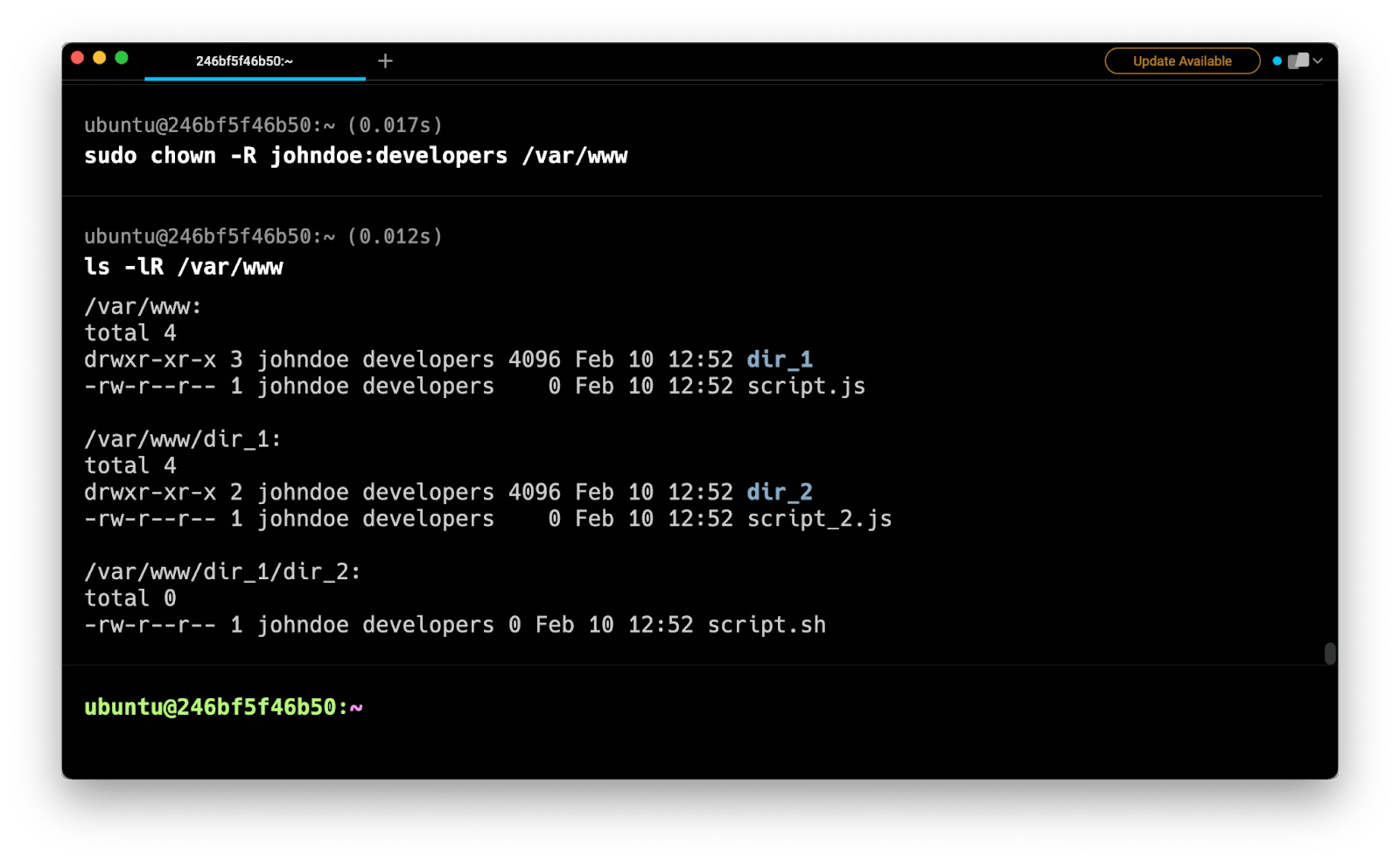
This command will recursively change the ownership of the specified directory and all its subdirectories and files. Use with caution to avoid unintended consequences.
|
Command Syntax |
Description |
Use Case Example |
|
|
Changes ownership of a single file |
chown alice report.txt |
|
|
Changes ownership of a directory (non-recursive) |
chown alice /data/ |
|
|
Recursively changes ownership of directory |
chown -R alice /data/ |
|
|
Changes owner and group of a file |
chown alice:staff report.txt |
|
|
Changes ownership of all files in current dir |
find . -type f -exec chown alice {} \; |
|
|
Changes ownership of all directories in current dir |
find . -type d -exec chown alice {} \; |
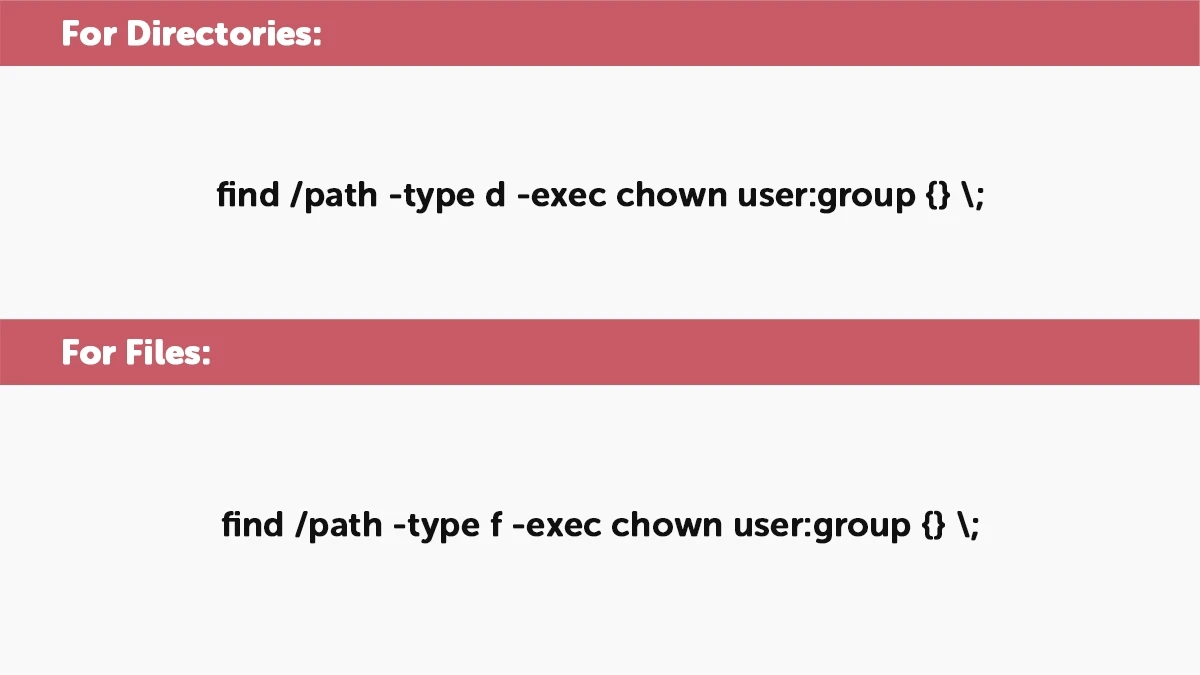
Chown Recursive Using –R Flag
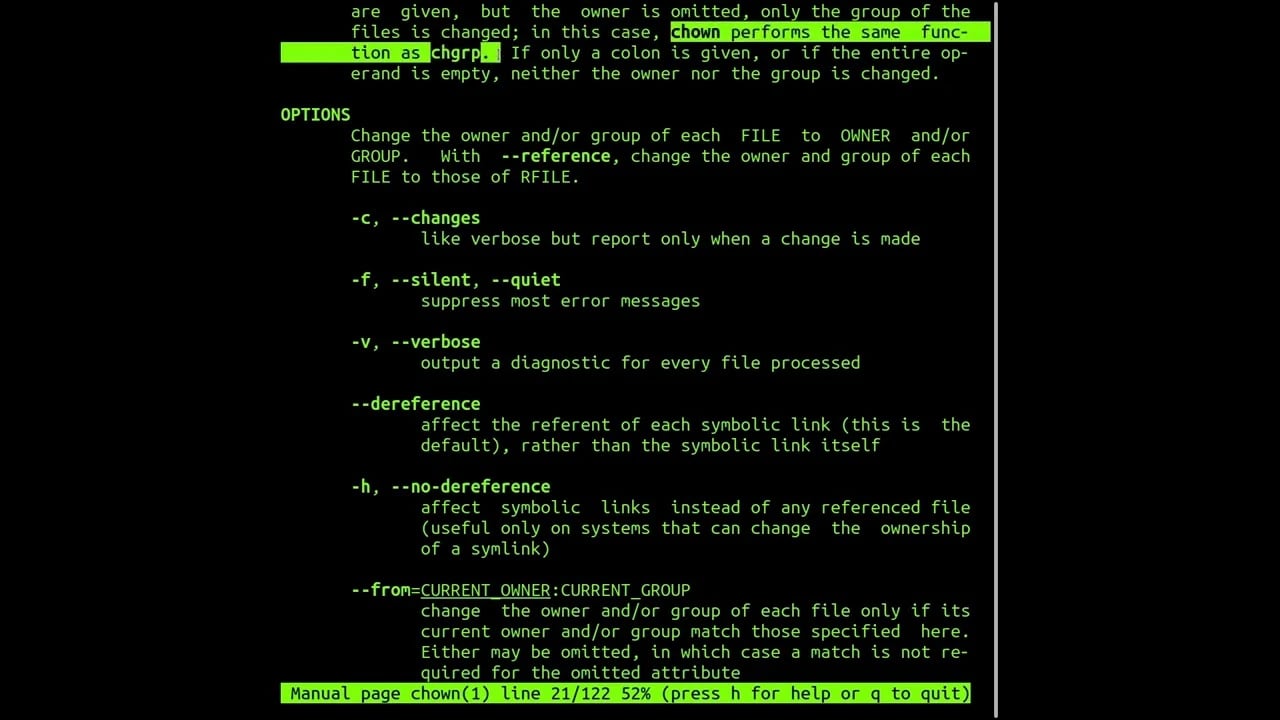
Welcome to the realm of file ownership management where the power of chown recursive reigns supreme, and at the heart of this command lies the mighty -R flag. Like a master key that unlocks the doors to entire kingdoms, the -R flag empowers you to extend the reach of chown recursive, enabling ownership changes to cascade effortlessly through directory structures with unparalleled efficiency and precision.
Imagine you're standing at the threshold of a vast digital kingdom, a sprawling landscape of directories and files, each with its own unique ownership settings. Your task? To ensure that ownership changes you make at the top level permeate through every nook and cranny below. This is where the -R flag becomes your loyal companion, turning an arduous journey into a seamless adventure.
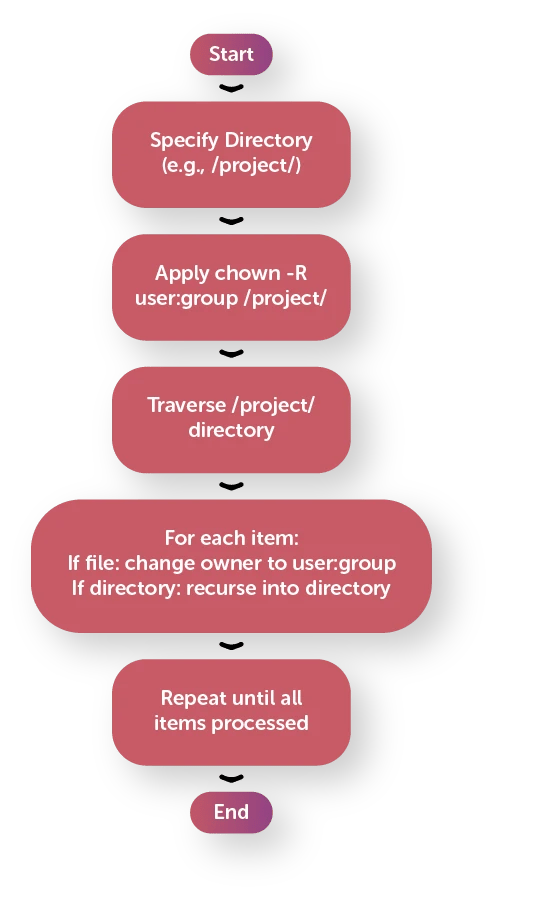
Comprehensive Ownership Adjustment
With the -R flag unfurled, chown recursive becomes a force to be reckoned with, traversing through directory trees with unparalleled agility. Whether you're transferring ownership of a single directory or an entire kingdom of files, the -R flag ensures that your commands echo through every corner of the digital realm, leaving no stone unturned.
Efficiency Redefined
Time is of the essence in the fast-paced world of system administration, and the -R flag is your secret weapon for maximizing efficiency. Instead of laboriously applying ownership changes to each file and directory individually, a single invocation of chown recursive with the -R flag does the heavy lifting for you, freeing up precious time for more strategic endeavors.
Ensuring Consistency
Just as a skilled architect ensures uniformity in a sprawling cityscape, the -R flag maintains consistency across your file system. By applying ownership changes recursively, you eliminate discrepancies that can lead to confusion or security vulnerabilities, fostering a harmonious environment where every file and directory adheres to the same set of rules.
Automating Routine Tasks
In the age of automation, chown recursive with the -R flag is your trusted ally for streamlining repetitive tasks. Whether you're managing user environments, configuring server permissions, or deploying applications, the ability to script ownership changes with the -R flag at your side enables you to automate workflows and enhance productivity with ease.
Navigating Complex Environments
From the labyrinthine depths of Linux to the intricate pathways of macOS, the -R flag knows no boundaries. Its versatility transcends operating system constraints, allowing you to wield the power of chown recursive with confidence regardless of your digital ecosystem. Whether you're sailing through Unix territories or exploring the nuances of BSD, the -R flag remains your steadfast companion in the journey of ownership management.
Scaling with Confidence
As your digital empire expands, so too does the complexity of ownership management. Yet, with the -R flag by your side, you can scale operations with confidence, knowing that chown recursive will adapt seamlessly to the evolving needs of your kingdom. Whether you're overseeing a small-scale project or orchestrating a vast network of interconnected systems, the -R flag ensures that ownership changes propagate with precision, allowing you to maintain control and order amidst the chaos.
In essence, the -R flag transforms chown recursive from a mere command into a formidable tool for conquering the complexities of ownership management. So, unfurl your flag, embark on your journey, and let the power of chown recursive with the -R flag guide you towards a realm of efficiency, consistency, and control within your digital kingdom.
chown -R newowner:newgroup /path/to/directory
In this example:
- -R is the flag that makes the command recursive.
- newowner is the new owner of the directory and its contents.
- newgroup is the new group associated with the owner (optional).
- /path/to/directory is the path to the directory whose ownership you want to change.
Chown recursive example
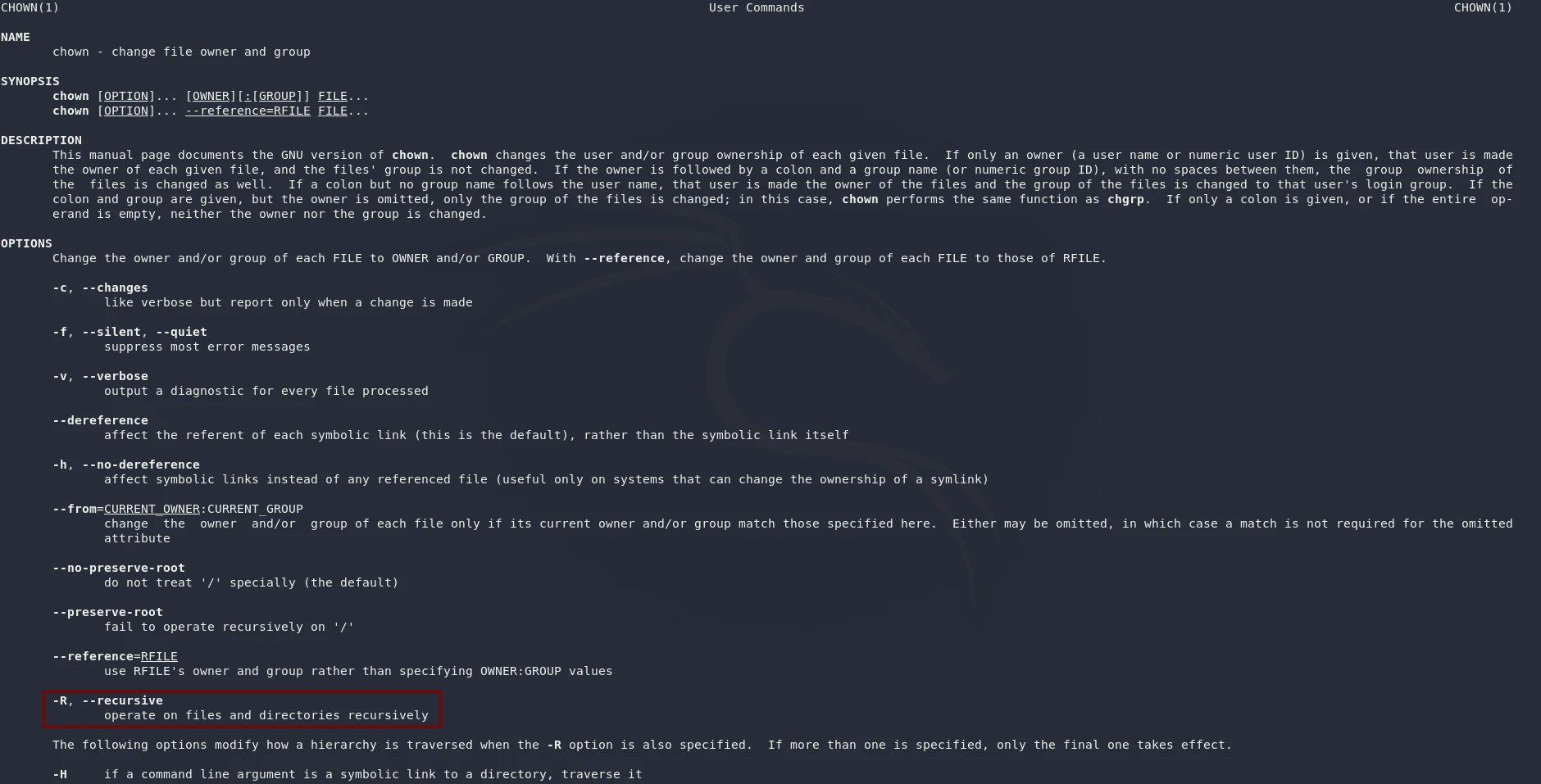
Welcome to the realm of ownership management, where chown recursive stands as a beacon of control and organization. Let's embark on a journey through a practical chown recursive example, exploring its versatility and power in action.
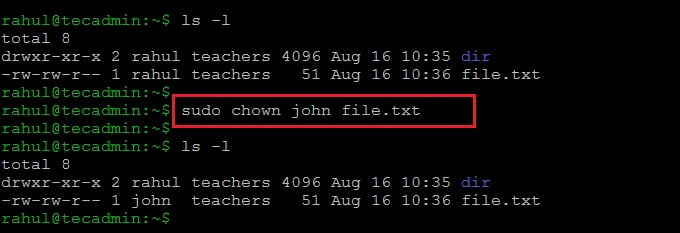
Imagine you're the steward of a vast digital library, where files and directories represent the precious volumes of knowledge within. Your task? To ensure that ownership of these treasures is aligned with your stewardship responsibilities. Enter chown recursive, your trusted ally in this endeavor.
Transferring Ownership
Suppose you've inherited a directory named "Library" containing countless subdirectories and files. With a single command—chown -R new_owner:group Library/—you can seamlessly transfer ownership of the entire library and all its contents to a new steward. The recursive nature of this command ensures that ownership changes cascade through every level of the directory hierarchy, sparing you the need to manually adjust each file and subdirectory.
User Management
In a bustling digital community, user permissions are paramount. Let's say you need to grant a new user access to a specific directory and its contents. With chown recursive, you can swiftly assign ownership to the designated user—chown -R new_user:group Directory/—granting them the keys to the kingdom while maintaining order and security across the board.
Project Collaboration
Picture a collaborative project directory where multiple team members contribute their expertise. To streamline collaboration and ensure accountability, you can use chown recursive to assign ownership of the project directory to a dedicated project group—chown -R :project_group Project_Directory/. With ownership clearly defined, team members can navigate the project landscape with confidence, knowing their contributions are valued and protected.
Server Administration
Managing a server environment requires finesse and attention to detail. Let's say you're tasked with updating ownership settings across multiple directories to comply with security protocols. With chown recursive, you can execute a single command—chown -R admin:admin_group Server_Directory/—to uniformly adjust ownership throughout the server hierarchy, ensuring consistency and adherence to best practices.
System Maintenance
As your digital domain evolves, periodic maintenance becomes essential to uphold system integrity. With chown recursive, you can facilitate routine maintenance tasks with ease. For instance, you can reset ownership to default settings—chown -R root:root System_Directory/—ensuring that system files remain under the stewardship of the root user, safeguarding against unauthorized modifications.
Data Migration
When migrating data between storage devices or servers, preserving ownership settings is paramount. With chown recursive, you can effortlessly transfer ownership of entire directory structures while maintaining data integrity—chown -R user:group Source_Directory/ Destination_Directory/. This ensures a seamless transition, minimizing disruptions and preserving the integrity of your digital assets.
In essence, the chown recursive example showcases the breadth of capabilities offered by this powerful command. Whether you're transferring ownership, managing user permissions, collaborating on projects, administering servers, performing system maintenance, or migrating data, chown recursive empowers you to navigate the complexities of ownership management with confidence and ease. So, wield it wisely, and let it be your guiding light in the realm of digital stewardship.
Chown recursive all files and folders
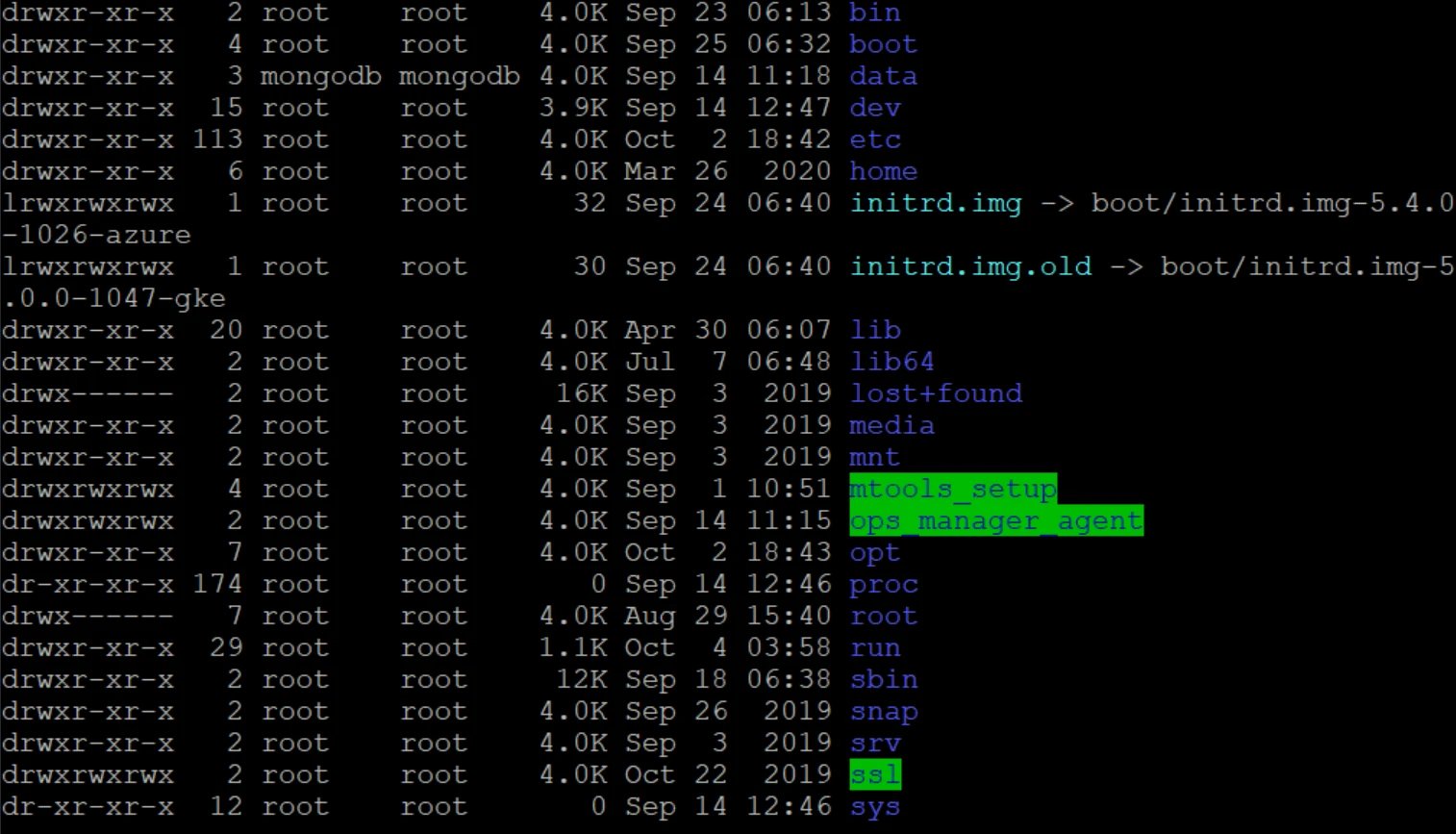
Welcome to the realm of digital governance, where the chown recursive command serves as your sovereign decree over file ownership. In this vast landscape of directories and files, ensuring uniformity and consistency is paramount. Enter chown recursive all files and folders, your trusted tool for establishing order and control throughout your digital domain.
Imagine you're the steward of a grand library, where every book and shelf represents a unique piece of knowledge within your collection. Your task? To ensure that every corner of your library reflects your stewardship, from the highest tower to the deepest dungeon. This is where chown recursive all files and folders emerges as your loyal companion, allowing you to assert your authority with precision and efficiency.
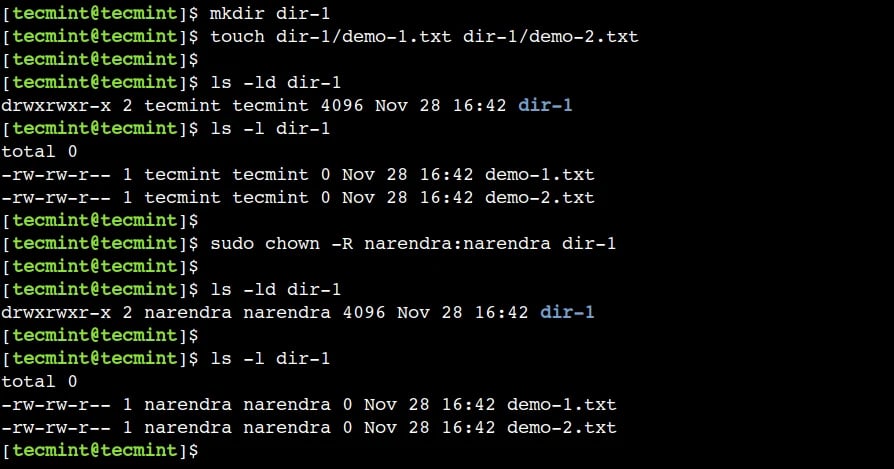
Comprehensive Ownership Adjustment
With a single invocation of chown recursive, you can exert your influence over every file and folder within your library—chown -R new_owner:group Library/. The recursive nature of this command ensures that ownership changes cascade seamlessly throughout the entire directory structure, sparing you the need to manually adjust each individual piece.
Streamlining User Permissions
Just as a benevolent ruler grants access to their loyal subjects, you can use chown recursive to manage user permissions with ease. Need to grant a new scholar access to the entire library? Simply wield chown recursive to assign ownership to the designated user—chown -R new_scholar:library_staff Library/. With ownership firmly established, scholars can delve into the depths of knowledge without constraint, knowing their access is sanctioned by the library's steward.
Project Collaboration
In the bustling halls of collaboration, where scribes and historians work side by side, chown recursive serves as the catalyst for creativity and teamwork. Let's say you're overseeing a grand historical research project where multiple scholars contribute their expertise. With chown recursive, you can assign ownership of the project directory to a dedicated research group—chown -R :historians_guild Research_Project/. With ownership clearly defined, scholars can collaborate freely, knowing their contributions are valued and protected.
Server Administration
Managing the infrastructure of your digital library requires diligence and expertise. Let's say you're tasked with updating ownership settings across multiple servers to ensure the library's resources remain accessible. With chown recursive, you can execute a single command—chown -R library_admin:library_staff Server_Directory/—to uniformly adjust ownership throughout the server hierarchy, safeguarding against unauthorized access.
Data Integrity and Security
Like a vigilant guardian, chown recursive all files and folders protects the integrity and security of your digital repository. By establishing uniform ownership settings, you mitigate the risk of data breaches and unauthorized access, ensuring that your library remains a bastion of knowledge and wisdom.
Safeguarding Against Chaos
In the ever-changing landscape of digital governance, maintaining order amidst chaos is paramount. With chown recursive all files and folders, you can assert your authority over every aspect of your library, from the most cherished tome to the humblest scroll. By establishing consistent ownership settings, you create a foundation of stability and reliability that withstands the test of time.
In essence, chown recursive all files and folders embodies the essence of control and organization within your digital library. Whether you're managing user permissions, fostering collaboration, administering infrastructure, or safeguarding data integrity, chown recursive stands as your unwavering ally, enabling you to navigate the complexities of ownership management with grace and mastery. So, wield it wisely, and let it be the cornerstone of your digital sovereignty.
Here's an example of how to use the chown command to recursively change the owner of all files and folders within a directory:
chown -R newowner:newgroup /path/to/directoryIn this command:
- chown is the command to change the owner of files and directories.
- -R is the flag that applies the command recursively to all files and directories within the specified directory.
- newowner is the username of the new owner.
- newgroup is the group name (this part is optional, but commonly used).
- /path/to/directory is the path to the directory where you want to change ownership.
For example, if you want to change the owner to user1 and the group to group1 for all files and folders within /home/example, you would use:
chown -R user1:group1 /home/example
This command will change the ownership of /home/example and all of its contents to user1 and group1.
Chown recursive c
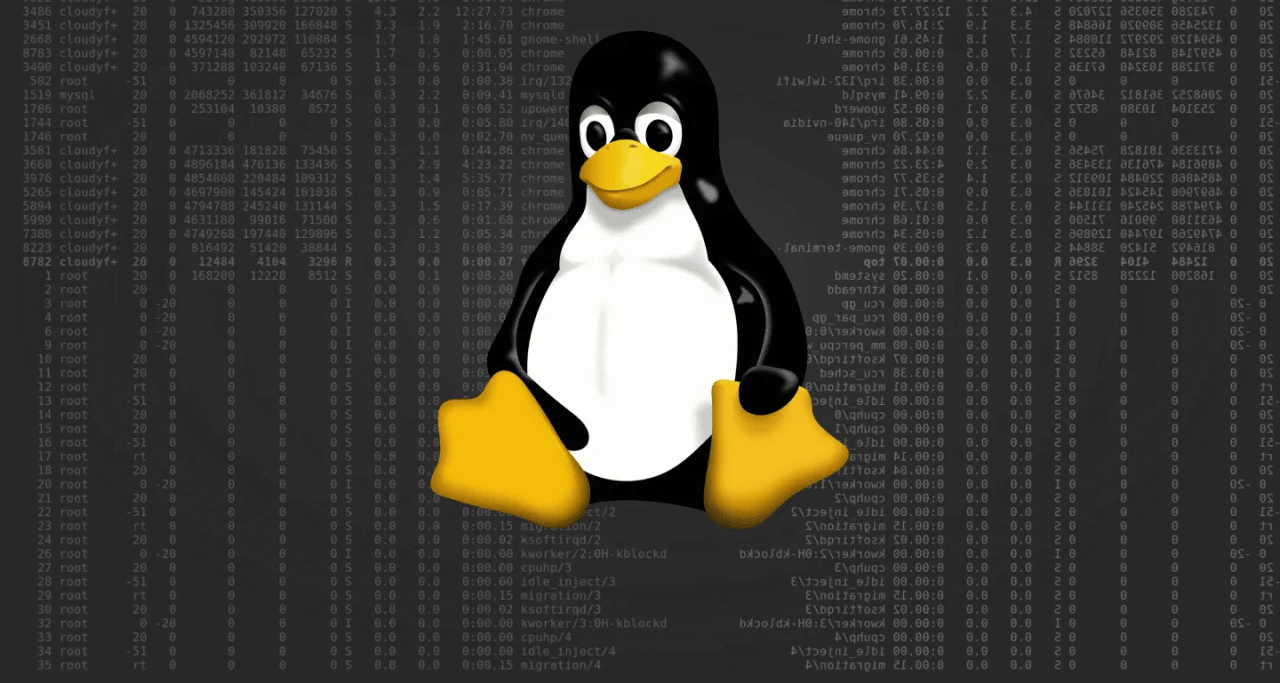

Sure, let's delve into the intriguing world of recursive file ownership changes using the chown command in Linux. Imagine you have a directory filled with files and subdirectories, each with their own owner. Now, you want to change the ownership of all files and directories within that directory, including those within its subdirectories. This is where chown with the recursive (-R) flag comes into play.
Here's a practical explanation:
Let's say you're the administrator of a shared web hosting server. You have a directory named "websites" where each user's website files are stored in separate subdirectories. However, due to a system migration, you need to change the ownership of all files and directories within the "websites" directory to a new user, let's call them "newuser".
Firstly, navigate to the parent directory containing "websites". To recursively change the ownership of all files and subdirectories within "websites" to "newuser", you'd use the chown command with the -R flag like so:
sudo chown -R newuser websites
Let's break this down:
-
sudo: This command is used to execute commands with superuser privileges. Since changing ownership of files typically requires elevated permissions, we use sudo to ensure the command executes successfully.
-
chown: This is the command used to change the ownership of files and directories.
-
-R: This is the recursive flag. It tells chown to operate recursively, meaning it will change the ownership of the specified directory and all of its contents, including subdirectories and their contents.
-
newuser: This is the new owner you want to assign to all files and directories within "websites".
-
websites: This is the directory whose ownership you want to change recursively.
By executing this command, chown will traverse through each directory and subdirectory within "websites", changing the ownership of every file and directory it encounters to "newuser".
So, to summarize, the chown command with the -R flag is a powerful tool for recursively changing ownership of files and directories in Linux, especially useful in scenarios like server administration where you need to manage permissions across a large number of files and directories.
Python chown recursive
Let's dive into the fascinating world ofpython chown recursive and its capability to recursively change file ownership using the os module. Imagine you're developing a file management application where you need to provide users with the ability to change ownership of entire directories, including all files and subdirectories within them. This is where Python's os module and recursive functions come into play.
Here's a captivating and practical explanation:
Picture yourself as the creator of a cloud storage service. Users upload files and organize them into directories. Now, as part of enhancing user control, you want to implement a feature that allows users to transfer ownership of their directories, including all files and subdirectories within them, to another user.
To achieve this in Python, you can use a recursive function along with the os module. Let's create a function called chown_recursive:
· python code
import os def chown_recursive(directory, new_owner_uid, new_owner_gid): # Change ownership of the directory itself os.chown(directory, new_owner_uid, new_owner_gid) # Iterate over all the contents of the directory for root, dirs, files in os.walk(directory): for d in dirs: # Change ownership of subdirectories os.chown(os.path.join(root, d), new_owner_uid, new_owner_gid) for f in files: # Change ownership of files os.chown(os.path.join(root, f), new_owner_uid, new_owner_gid) # Example usage: chown_recursive('/path/to/directory', new_owner_uid, new_owner_gid)
Let's unravel this:
-
import os: This line imports the os module, which provides a portable way of interacting with the operating system, including file operations.
-
def chown_recursive(directory, new_owner_uid, new_owner_gid): This defines a function named chown_recursive that takes three parameters: directory (the directory whose ownership needs to be changed), new_owner_uid (the new owner's user ID), and new_owner_gid (the new owner's group ID).
-
os.chown(directory, new_owner_uid, new_owner_gid): This line changes the ownership of the directory itself to the specified user ID and group ID.
-
for root, dirs, files in os.walk(directory): This line uses the os.walk() function to recursively iterate over all contents of the directory, including subdirectories and files.
-
os.chown(os.path.join(root, d), new_owner_uid, new_owner_gid): This line changes the ownership of each subdirectory encountered during traversal.
-
os.chown(os.path.join(root, f), new_owner_uid, new_owner_gid): This line changes the ownership of each file encountered during traversal.
By calling chown_recursive with the appropriate parameters, you can recursively change the ownership of all files and subdirectories within a directory, making it a powerful tool for managing file ownership in Python.
So, whether you're building a file management system, a cloud storage service, or any other application that requires managing file ownership, Python's ability to recursively change ownership using the os module empowers you to create robust and user-friendly solutions.
Chown recursive mac
Let's explore the intriguing world of macOS and its recursive file ownership changes using the chown command. Imagine you're a macOS power user managing a directory containing numerous files and subdirectories. You need to change the ownership of all files and directories within that directory, including those nested deeply within its subdirectories. This is where chown with the recursive flag comes into play, enabling you to efficiently manage permissions across your macOS system.
Here's an engaging and practical explanation:
Imagine you're a creative professional working on a multimedia project with various collaborators. You've organized your project files into a master directory on your macOS system. Now, as you prepare to share the project with your team, you realize that you need to adjust the ownership of all files and directories within the master directory to ensure proper access permissions for everyone involved.
To accomplish this task in macOS, you'll utilize the chown command with the -R flag. Let's walk through the process:
-
Open the Terminal application on your macOS system.
-
Navigate to the directory containing your master project folder using the cd command. For example:
cd /path/to/master_project_folder
-
Now, it's time to recursively change the ownership of all files and directories within the master project folder. You'll use the chown command with the -R flag, specifying the desired user and group ownership. For instance, let's say you want to change the ownership to a new user named "collaborator" and a group named "project_team":
sudo chown -R collaborator:project_team master_project_folder
-
macOS will prompt you to enter your administrator password since changing file ownership requires elevated privileges. After providing your password, chown will recursively traverse through the master project folder, updating the ownership of each file and directory encountered to the specified user and group.
-
Once the process completes, all files and directories within the master project folder, including those nested deeply within its subdirectories, will have their ownership successfully changed.
By utilizing chown with the recursive flag, you've efficiently managed permissions across your macOS system, ensuring that your collaborative project remains accessible and secure for all team members.
Whether you're working on creative projects, managing development environments, or organizing system files, chown recursive functionality empowers macOS users to streamline the process of adjusting file ownership with ease and efficiency.
Chown recursive hidden files
Let's delve into the fascinating world of managing hidden files and directories using the chown command with recursive capabilities. Imagine you're a seasoned developer working on a project with numerous hidden configuration files scattered throughout your directory structure. You need to adjust the ownership of these hidden files along with the visible ones to ensure proper access permissions. This is where chown with the recursive flag proves invaluable, enabling you to seamlessly manage ownership across all files, including those hidden from plain sight.
Here's an engaging and practical explanation:
Imagine you're a software engineer working on a sophisticated web application hosted on a Linux server. Your project directory contains a plethora of configuration files, some of which are hidden (prefixed with a dot). These hidden files play a crucial role in fine-tuning your application's behavior, and it's essential to ensure that they have the correct ownership for seamless deployment and operation.
To tackle this task efficiently, you'll leverage the chown command with the recursive flag, specifically targeting both visible and hidden files. Let's walk through the process step by step:
-
Open your terminal or command prompt, and navigate to the root directory of your project where both visible and hidden files reside.
-
Now, it's time to execute the chown command with the recursive flag to adjust the ownership of all files, including hidden ones. Let's assume you want to change the ownership to a new user named "webuser" and a group named "webgroup":
sudo chown -R webuser:webgroup .
-
Upon running this command, chown will recursively traverse through the project directory, including all subdirectories, and adjust the ownership of each file and directory encountered. Crucially, it will also include hidden files, ensuring comprehensive ownership management.
-
As the command executes, you may be prompted to enter your administrator password, as changing file ownership typically requires elevated privileges. Once authenticated, chown will proceed to update ownership seamlessly.
-
Once the process completes, all files within your project directory, whether visible or hidden, will have their ownership successfully changed to the specified user and group.
By harnessing the power of chown with the recursive flag, you've effectively managed ownership across your project directory, encompassing both visible files and those concealed from casual observation.
Whether you're configuring web servers, managing development environments, or maintaining intricate file structures, chown recursive capabilities offer a versatile solution for handling ownership adjustments with precision and ease, ensuring optimal performance and security for your projects.
Conclusion
In conclusion, chown recursive emerges as the cornerstone of control and organization within the intricate landscape of file ownership management. With its versatile capabilities, this command empowers users to assert authority over every aspect of their digital domain, from individual files to entire directory structures.
Through a journey across various scenarios, we've witnessed the transformative power of chown recursive in action. Whether transferring ownership, managing user permissions, fostering collaboration, administering infrastructure, safeguarding data integrity, or maintaining order amidst chaos, chown recursive stands as a steadfast ally, enabling users to navigate the complexities of ownership management with grace and mastery.
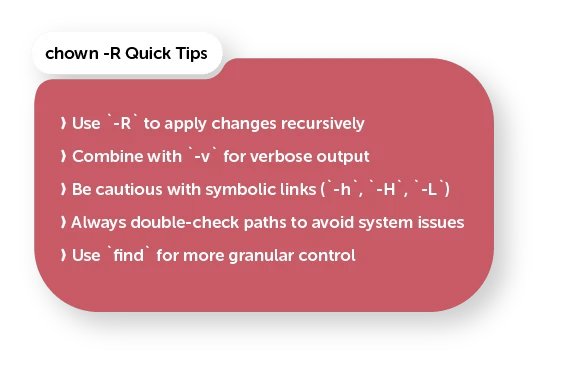
From the bustling halls of collaboration to the fortified walls of digital fortresses, chown recursive serves as the sovereign decree, ensuring that ownership settings align with the stewardship responsibilities of users. With each invocation of chown recursive, users wield authority with precision and finesse, establishing consistency and reliability throughout their digital landscape.
So, let us embrace the power of chown recursive as the cornerstone of digital sovereignty, guiding us towards a realm of efficiency, security, and control within our digital domain. With chown recursive at our side, we navigate the complexities of ownership management with confidence, knowing that we hold the keys to our digital destiny.











